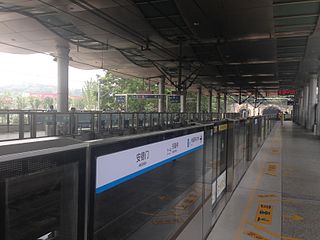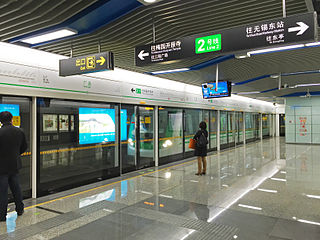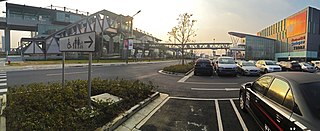
Qiaocheng East station, formerly Qiaochengdong station, is a station on Line 1 of the Shenzhen Metro. It opened on 28 December 2004. It is located underground at Shennan Dadao, west of Qiaochengdong Lu and east of Xiaoshahe Lu, in Futian District, Shenzhen, China. It is near the east end of Splendid China Folk Village and Overseas Chinese Town, hence its name.

Taoyuan station, is a station on Line 1 of the Shenzhen Metro in Shenzhen, Guangdong Province, China. It was opened on 15 June 2011, with the extension of Line 1.

Andemen station, is a transfer station of Line 1 and Line 10 of the Nanjing Metro. It started operations on 3 September 2005 as part of Line 1's Phase I that ran north to Maigaoqiao; the previous branch of Line 1 from this station to Olympic Stadium was re-designated as Line 10 when that line opened on 1 July 2014, and Andemen became the eastern terminus of Line 10.

Xiaohang station, is a station of Line 10 of the Nanjing Metro. It started operations on 3 September 2005 as part of Line 1's Phase I that ran from Maigaoqiao to Olympic Stadium. On 1 July 2014, with the opening of Line 10, the former branch of Line 1 from Andemen to Olympic Stadium became re-designated as Line 10.

Xiaolongwan station, is a station of Line 1 of the Nanjing Metro. It began operations on 28 May 2010, as part of the southern extension of line 1 from Andemen to CPU.

Youfangqiao station, known as Wangjiacun station during planning until 2007, is a station on Line 2 and Line S3 of the Nanjing Metro. It started operations on 28 May 2010 along with the rest of Line 2. The interchange with Line S3 opened on 26 December 2017 with the opening of that line.

Xiamafang station, formerly Xiaoweijie station during planning until 2007, is a station of Line 2 of the Nanjing Metro. It started operations on 28 May 2010 along with the rest of Line 2.

Sanyang Plaza station, is an interchange station of Line 1 and Line 2 of the Wuxi Metro. It started operations on 1 July 2014. It is the largest metro station of China.

Xizhang Station, is a metro station of Line 1, Wuxi Metro. It started operations on 1 July 2014.

Minfeng Station, is a metro station of Line 1, Wuxi Metro. It started operations on 1 July 2014.
Nanchan Temple Station, is a metro station of Line 1, Wuxi Metro. It started operations on 1 July 2014.

Qingmingqiao Station, is a metro station of Line 1, Wuxi Metro. It started operations on 1 July 2014.

Huaqingdaqiao Station, is a metro station of Line 1, Wuxi Metro. It started operations on 1 July 2014.

Donglin Plaza Station, is a metro station of Line 2, Wuxi Metro. It started operations on 28 December 2014. The station is near Donglin Academy.

Guangyi Station, is a metro station of Line 2, Wuxi Metro. It started operations on 28 December 2014.

Baizhuang Station, is a metro station of Line 2, Wuxi Metro. It started operations on 28 December 2014.

Yunlin Station, is a metro station of Line 2, Wuxi Metro. It started operations on 28 December 2014. The station is near Wuxi IKEA Store, B&Q, Decathlon.

Jiulihe Park Station, is a metro station of Line 2, Wuxi Metro. It started operations on 28 December 2014.

Taoyuancun station is a Metro station of Shenzhen Metro Line 7. It opened on 28 October 2016.

Huangmugang station is a Metro station of Shenzhen Metro Line 7. It opened on 28 October 2016.






















